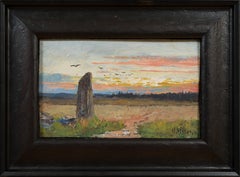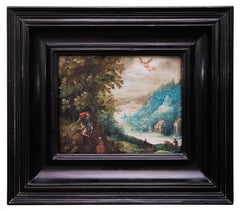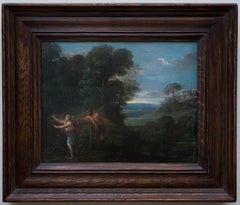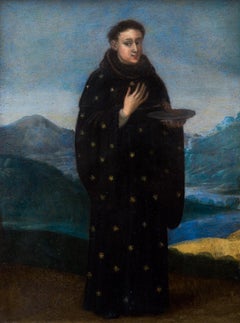Video Loading
Want more images or videos?
Request additional images or videos from the seller
1 of 10
Eric HallströmNaïvism Painting from the early 1900s Called "Catch of the Day"c. 1920-1930
c. 1920-1930
Price:$1,665.47
$2,282.97List Price
About the Item
- Creator:Eric Hallström (1893 - 1946, Swedish)
- Creation Year:c. 1920-1930
- Dimensions:Height: 12.01 in (30.5 cm)Width: 17.13 in (43.5 cm)
- Medium:
- Period:
- Condition:The surface of the oil painting has been recently cleaned.
- Gallery Location:Stockholm, SE
- Reference Number:1stDibs: LU1445214597592
About the Seller
5.0
Platinum Seller
Premium sellers with a 4.7+ rating and 24-hour response times
Established in 2020
1stDibs seller since 2020
221 sales on 1stDibs
Typical response time: 1 hour
Associations
International Confederation of Art and Antique Dealers' Associations
Authenticity Guarantee
In the unlikely event there’s an issue with an item’s authenticity, contact us within 1 year for a full refund. DetailsMoney-Back Guarantee
If your item is not as described, is damaged in transit, or does not arrive, contact us within 7 days for a full refund. Details24-Hour Cancellation
You have a 24-hour grace period in which to reconsider your purchase, with no questions asked.Vetted Professional Sellers
Our world-class sellers must adhere to strict standards for service and quality, maintaining the integrity of our listings.Price-Match Guarantee
If you find that a seller listed the same item for a lower price elsewhere, we’ll match it.Trusted Global Delivery
Our best-in-class carrier network provides specialized shipping options worldwide, including custom delivery.You May Also Like
1903 Walpi Hopi Village, Arizona First Mesa Landscape circle of Elmer Wachtel
By Marion Kavanaugh Wachtel
Located in Soquel, CA
Walpi Hopi Village, Arizona First Mesa Landscape by Marion Kavanaugh Wachtel. Significant southwestern painting of Hopi at Walpi Mesa in Arizona...
Category
Early 1900s Hudson River School Landscape Paintings
Materials
Gold Leaf
$20,000 Sale Price
20% Off
H 30 in W 34 in D 2 in
Stag Hunting in the Vicinity of Nuremberg by a German Artist Peter von Bemmel
Located in PARIS, FR
This small landscape shows a hunting scene: two riders are chasing a stag with their dogs at the edge of a forest. Signed by Peter von Bemmel, it is typical of the production of this...
Category
1720s Old Masters Landscape Paintings
Materials
Copper
Two Scenes of Diana and Actaeon (a pair)
By Giovanni Battista Viola
Located in New York, NY
Provenance:
Robert L. and Bertina Suida Manning, New York, until 1996
Private Collection, USA
Giovanni Battista Viola was born in Bologna a...
Category
17th Century Baroque Landscape Paintings
Materials
Copper
Oil painting on board "Rough sea with steamer on the horizon" by S.A.Vinogradoff
Located in Gavere, BE
Sergey VINOGRADOV ( 1869 - 1938 )
Rough sea with steamer on the horizon
Sergei Arsenievich Vinogradov ( Russian: 1869–1938 ) was a Russian-Soviet Impressionist painter; known for l...
Category
1920s Expressionist Landscape Paintings
Materials
Gold Leaf
$9,036 Sale Price
20% Off
H 21.26 in W 24.41 in D 2.37 in
'The Music Contest between Apollo and Pan', Renaissance Mythology, Satyr, Hermes
By Flemish School, 17th Century
Located in Santa Cruz, CA
An early 17th-century Flemish School oil on copper showing the mythological contest between Apollo and Pan in which the mountain god, Tmolus, gives judgement for Apollo. Unsigned. Pa...
Category
Early 17th Century Northern Renaissance Figurative Paintings
Materials
Copper
$19,600 Sale Price
20% Off
H 19 in W 25.25 in
Five mid 20th century Italian oil landscapes with figures, castles, Churchs
Located in Woodbury, CT
A very interesting set of five mid-20th-century Italian oils on copper.
All five are classical landscape subjects and are signed Roger, though we don't know which artist with the n...
Category
1950s Old Masters Landscape Paintings
Materials
Copper
$4,517 Sale Price
35% Off
Free Shipping
H 7 in W 5 in
Mark's Tornado #1 - Oil Painting on Gold Leaf, Sky, Landscape, Weather, Clouds
Located in Denton, TX
Mark's Tornado #1 by Pam Burnley-Schol depicts a stormy sepia toned sky, with dark clouds forming a tornado, framed by a gold leaf border.
Oil Painting on Gold Leaf on Panel
16 x 16...
Category
2010s Contemporary Landscape Paintings
Materials
Gold Leaf
$2,300
H 16 in W 16 in D 2 in
Oil painting on canvas coastal scene "Nightfall on the North Sea " ca. 1880
Located in Gavere, BE
Additional information:
Title: Coastal scene - Nightfall on the North Sea
Medium: oil on canvas
Signature: signed lower right
Provenance: Private collection Brussels
Canvas dimensio...
Category
1880s Impressionist Landscape Paintings
Materials
Gold Leaf
$9,393
H 26.78 in W 34.26 in D 4.34 in
Impressionist Oil On Canvas "at the lake" by André Van Beek
Located in Gavere, BE
André van Beek was born in 1947 to a Dutch father and a French mother. The latter was a music teacher. Self-taught, with a post-impressionist tendency, André van Beek is an artist wh...
Category
Mid-20th Century Impressionist Landscape Paintings
Materials
Gold Leaf
$1,545
H 17.72 in W 14.97 in D 0.79 in
Oil painting on canvas " Rough sea with coastline on the horizon " by Schubring
By Richard Schubring
Located in Gavere, BE
Schubring, Richard (1853-1902)
Rough sea with coastline on the horizon
Oil on canvas. Signed and dated lower right. “1895”
Richard SCHUBRING is an artist born in 1853 and deceased...
Category
1890s Expressionist Landscape Paintings
Materials
Gold Leaf
$5,350
H 11.82 in W 16.93 in D 0.79 in
More From This Seller
View AllThe Memorial Stone, Uppland (Swedish Bautasten i Uppland) 1901
By Olof Hermelin
Located in Stockholm, SE
This atmospheric study shows a solitary standing stone rising in the flat landscape of Uppland, silhouetted against a luminous sunset sky. Broad, animated brushstrokes capture the sh...
Category
Early 1900s Post-Impressionist Landscape Paintings
Materials
Metal
Abraham and the Sacrifice of His Son Isaac by Adriaen Van Stalbemt, C. 1605-1610
Located in Stockholm, SE
Artist: Adriaen van Stalbemt (Stalbempt) 1580-1662
Title: Abraham and the Sacrifice of His Son Isaac “Das Opfer des Abraham”
According to the Old...
Category
Early 1600s Old Masters Landscape Paintings
Materials
Copper
Landscape With Pan and Syrinx, Flemish School From the 1600s, Oil on Copper
Located in Stockholm, SE
Flemish School, 1600s
Landscape With Pan and Syrinx
painted around the 1600s
oil on copper
19 x 23.5 cm
frame 29 x 34 cm
Hand-made oak frame by Swedish frame maker Christer Björkma...
Category
17th Century Old Masters Landscape Paintings
Materials
Copper
Old Master Painting, Flemish School from 1600s, Saint Nicholas of Tolentino
Located in Stockholm, SE
This small Flemish painting, measuring only 24.5 x 18.5 cm and executed on a copper plate, depicts Saint Nicholas of Tolentino. Created in the 17th century, the artist remains unknow...
Category
17th Century Old Masters Landscape Paintings
Materials
Copper
$4,013 Sale Price
25% Off
Sankt Matteus Church in Stockholm, 1907
Located in Stockholm, SE
The painting we are offering for sale, executed by Swedish artist Erik Tryggelin on May 3, 1907, presents a striking and atmospheric view of Sankt Matteus Church in Stockholm. It sta...
Category
Early 1900s Post-Impressionist Landscape Paintings
Materials
Oil, Board
Lakeside at Gärdsvik, Ljusterö, 1891
Located in Stockholm, SE
In the soft evening light, a lone figure rows a small boat across the calm water, while tall reeds fringe the quiet shoreline in the foreground. Rolling wooded hills embrace the lake...
Category
1890s Impressionist Landscape Paintings
Materials
Canvas, Oil
Recently Viewed
View AllMore Ways To Browse
Antique Fishing Rods
Hawk Oil Painting
Ice Cream Painting
Kerala Art
Laurel Hardy
Leonardo Da Vinci Painting
Mohamed Abla
Oil Painting Cupid
Pearl Artwork
Peter Max Better World Acrylic Painting
Realistic Nude
Sports Oil Painting
Vintage Gulf Oil
Virgen Painting
Contemporary Impressionist Painting Woman
Harem Painting
Horse Cavalry
Leyendecker Study



